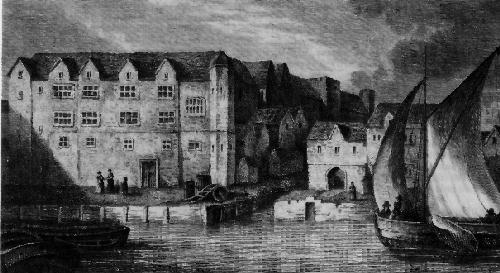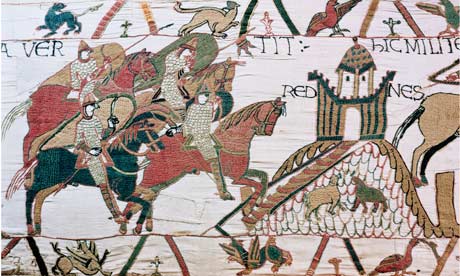The River Thames features in The Handfasted Wife and briefly in The Swan-Daughter. What do we know about the Thames from the eleventh century? It rose then as it rises today in Trewsbury Meade beside a Roman Camp and a mound known as Trewsbury Castle. The name of the neighboring village derives from the old Anglo-Saxon word for spring or source. It is called Ewen. The path of the early river is marked by a line of straggling ancient thorns. The Lydwell along the birth course is known as Lyd Well, meaning loud spring.
The river has many many tributaries. Close to where I live in Oxfordshire there are two interesting tributaries, the Cherwell and the Windrush. By the time the river reaches London there are buried tributaries such as the Fleet, a river that would have been navigable in the Anglo-Saxon era.
The Fleet is the greatest of all forgotten tributaries. It flows into the Thames under Blackfrairs Bridge. Its name may have derived from the Anglo-Saxon term for a tidal estuary or from the fleetness of water that gathered from it into the wells north of the city. Tributaries came together near Clerkenwell and Turnmill Street widening at Holborn where a bridge once crossed the Fleet. According to John Snow's Elizabethan survey of London the waters of The Fleet were so wide that ten ships with merchandise could use it at one time. It had also by the sixteenth century become in parts an open sewer that frequently needed cleansing.
The river Thames acted as a boundary in Anglo-Saxon times between Wessex and Mercia. At Cookham on the border between the two kingdoms there was a monastery that kept changing hands between the two. In the Anglo-Saxon Chronicle Wessex is written as The Kingdom South of the River, a poetic concept but one reinforcing the notion of the river as a boundary. In the seventh century London was known as Lundenwic. London quickly became an important port with trade links to continental Europe. When it was an Anglo-Saxon settlement, the early Saxons preserved commercial links with the Rhine. Imports of timber and resin came to Lundonwic by river and corn and wool were exported. Tolls were charged at Billingsgate and vessels were also charged fourpence to rest in the wharf.
During the early medieval period Hiths and Quays were constructed along the riverbank within the protection of a wall built to shield London from invaders. In fact, the invasion of the Thames did happen in 893 AD. A Danish army landed in the Thames Estuary because if they had control of the river this would result in control of the country nearby and then they could attack both Mercia and Wessex from this river sanctuary. They were counter-attacked in 895. The attacks continued throughout this period until Canute gained control of the Thames and took the throne of England from 1016-1035.
Peter Ackroyd writes that, according to the monastic chronicler Gildas, the Thames was always the river of boundaries, the guardian river. The Thames enters ancient charters from the seventh century on. From it we discover the existence of dene holes by the river which were vast underground tunnels that were likened to vase-shaped structures with narrow necks. Ackroyd describes these as having a vertical shaft with a bell like chamber below that led to other chambers. Some historians suggest that these were grain pits or refuges from invaders. They may have been constructed by the Anglo-Saxons for chalk mining although no one knows. I wonder if there could be treasure hidden in undiscovered dene holes on the banks of the Thames. It is an interesting thought. Perhaps I need to go looking.
You can find out more about the significance of the river in Peter Ackroyd's Thames: Sacred River. The river Thames and its tributaries features strongly in The Handfasted Wife and during a visit to London in The Swan-Daughter when a group of characters have difficulty crossing the crowded London Bridge on their way south to Canterbury.
 |
| At the Source or Close to it! |
The river has many many tributaries. Close to where I live in Oxfordshire there are two interesting tributaries, the Cherwell and the Windrush. By the time the river reaches London there are buried tributaries such as the Fleet, a river that would have been navigable in the Anglo-Saxon era.
 |
| Abingdon , a location on the river in The Handfasted Wife |
| Along the Thames in London |
The river Thames acted as a boundary in Anglo-Saxon times between Wessex and Mercia. At Cookham on the border between the two kingdoms there was a monastery that kept changing hands between the two. In the Anglo-Saxon Chronicle Wessex is written as The Kingdom South of the River, a poetic concept but one reinforcing the notion of the river as a boundary. In the seventh century London was known as Lundenwic. London quickly became an important port with trade links to continental Europe. When it was an Anglo-Saxon settlement, the early Saxons preserved commercial links with the Rhine. Imports of timber and resin came to Lundonwic by river and corn and wool were exported. Tolls were charged at Billingsgate and vessels were also charged fourpence to rest in the wharf.
 |
| Lambeth Bridge over the Thames |
During the early medieval period Hiths and Quays were constructed along the riverbank within the protection of a wall built to shield London from invaders. In fact, the invasion of the Thames did happen in 893 AD. A Danish army landed in the Thames Estuary because if they had control of the river this would result in control of the country nearby and then they could attack both Mercia and Wessex from this river sanctuary. They were counter-attacked in 895. The attacks continued throughout this period until Canute gained control of the Thames and took the throne of England from 1016-1035.
| The Danes are Coming |
Peter Ackroyd writes that, according to the monastic chronicler Gildas, the Thames was always the river of boundaries, the guardian river. The Thames enters ancient charters from the seventh century on. From it we discover the existence of dene holes by the river which were vast underground tunnels that were likened to vase-shaped structures with narrow necks. Ackroyd describes these as having a vertical shaft with a bell like chamber below that led to other chambers. Some historians suggest that these were grain pits or refuges from invaders. They may have been constructed by the Anglo-Saxons for chalk mining although no one knows. I wonder if there could be treasure hidden in undiscovered dene holes on the banks of the Thames. It is an interesting thought. Perhaps I need to go looking.
 |
| Cheapside and the Fleet |
You can find out more about the significance of the river in Peter Ackroyd's Thames: Sacred River. The river Thames and its tributaries features strongly in The Handfasted Wife and during a visit to London in The Swan-Daughter when a group of characters have difficulty crossing the crowded London Bridge on their way south to Canterbury.

_-_WGA24166.jpg)


























